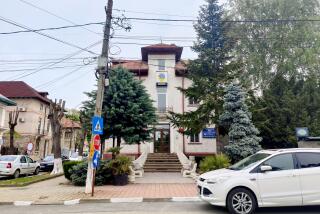Romanian City’s 4 Names Reflect Ethnic Strife
- Share via
CLUJ-NAPOCA, Romania — This Transylvanian city has four names, which trace its ethnic and political history.
To the Hungarians who ruled for centuries, it is Kolozsvar. Germans, who built neat villages all around, called it Klausenburg. To the Romanians who run it now, it is Cluj.
The fourth name, Cluj-Napoca, incorporates the city’s supposed Latin name. It is the only one found on signposts and on maps of the western region.
Nicolae Ceausescu, the Communist dictator overthrown and executed in December, imposed the hyphenated hybrid in 1966 as part of his attempt to prove that Romania had the strongest claim to Transylvania. Hardly anyone uses it in everyday speech.
Ceausescu’s policies of destroying tradition and fanning Romanian nationalism left a complex legacy in a region where, for centuries, three nationalities have farmed, built and battled, made peace and fought again.
After a brief period of shared elation when he was deposed, the approximately 5 million Romanians and 2 million Hungarians in Transylvania remain deeply divided.
For ethnic Hungarians in Transylvania, which borders Hungary, the new freedom means trying to regain such fundamental rights as education in their own language. Hungarian-language schools existed for 400 years in Kolozsvar. Ceausescu closed the last two in 1984.
In nearby Tirgu Mures, the medical school was predominantly Hungarian for centuries. A recent strike by ethnic Hungarian students, who demanded lectures in their own language, provoked a violent Romanian reaction.
At least six people were reported killed and 300 injured in ethnic rioting that pitted ethnic Romanians in the city against ethnic Hungarians.
Eva Gimesyi is one of several intellectuals who say they are trying to explain their education goals to Romanians, who suspect ethnic Hungarians of seeking autonomy. She is a philology professor at Cluj University.
Gimesyi, fellow ethnic Hungarian Lajos Kantor and others publish a journal called Bridge to disseminate their views.
They concede that it is an uphill task. Memories are long in the Balkans.
Romanians have not forgotten the excesses of Hungarian rule in the 18th and 19th centuries, or the brief return to Transylvania of Hungarian fascists during World War II.
Traditions of tolerance that accompanied the ancient enmity have all but disappeared in an urban landscape of drab houses and dirty factories. Villages preserved for centuries as badges of national pride have fallen into neglect.
“There is a very thin layer” of Romanian intellectuals “with whom we have common aims to re-enter Europe,” Gimesyi said in an interview.
She said most ethnic Romanians are “ignorant of Hungarian language and culture, discontent and . . . lacking in political culture.”
She and Kantor believe the bulk of Romanians, for that reason, could be susceptible to the nationalism of such groups as Vatra Romaneasca (Romanian Hearth), which ethnic Romanians founded Feb. 8 in Tirgu Mures.
Gimesyi and Kantor, mindful of the old intellectual dreams of Transylvania as a melting pot that could be a model to Europe, believe they and Romanians who share their views must try to win converts by patient argument.
Many Romanians instinctively distrust the ethnic Hungarians, whose case is weakened by nationalist sentiment inside Hungary itself.
In Hungary, people remember the loss of Transylvania and other territories as punishment for being the losing side in World War I.
The emotional attachment to Erdely--Hungarian for Transylvania--and Ceausescu’s harassment of ethnic Hungarians prompted Hungary, before the revolution, to lead international condemnation of a Warsaw Pact ally.
In 1988, Hungary took the unprecedented step of opening its borders to refugees from Romania.
Open nostalgia in Budapest for the beautiful mountains and rolling meadows of Transylvania feeds Romanian suspicions about the language debate.
“The claims of the Magyar minority are based on their conception that Transylvania is separate from Greater Romania,” said Iuliu Boila of the Cluj branch of the National Peasant Party, a pre-World War II political group revived since the revolution. “This is not true. We are one nation.”
Long suppression of ethnic identity and Ceausescu’s policy of resettling Romanians from other parts of the country in Transylvania reinforce Boila’s argument.
Communists “didn’t allow diversity to exist,” Gimesyi said. “They didn’t give individuals the right to make themselves distinct from others.”
Kantor said: “The 45 years of Communism had an irreversible, bad influence.”
Gimesyi’s own heritage--one grandmother ethnic German and the other ethnic Romanian--illustrates the delicate web of integration spun in old Transylvania.
One major change wrought on the region was the emigration of the German minority that, for centuries, acted as a kind of buffer between the Hungarians and Romanians.
In the 1930s, about 600,000 Germans lived in Transylvania. There were 380,000 in 1966, and now the number is just over 200,000.
Emigration of ethnic Germans averaged about 12,000 a year under Ceausescu, who made West Germany pay hard currency for each one.
The bright, painted houses the Germans leave behind either fall into ruin or are taken by a fast-growing Gypsy population that adds a new element to Transylvania’s ethnic mix.
More to Read
Sign up for Essential California
The most important California stories and recommendations in your inbox every morning.
You may occasionally receive promotional content from the Los Angeles Times.










